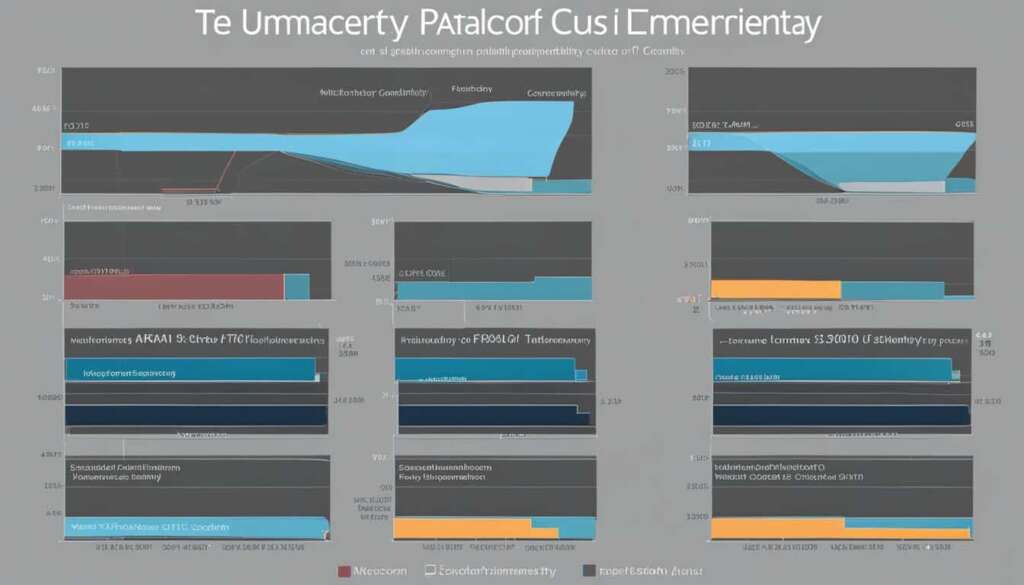Table of Contents
The Microsoft Compatibility Telemetry process, known as CompatTelRunner.exe, can consume a significant amount of CPU resources, causing sluggishness in the system. This process gathers technical data about the device’s performance and sends it to Microsoft for future updates. The high CPU usage can be caused by various factors like operating system issues, errors with the telemetry service, or corrupt system files. In this section, we will explore how to reduce the CPU usage caused by Microsoft Compatibility Telemetry and improve system performance.
Key Takeaways
- Microsoft Compatibility Telemetry, specifically the CompatTelRunner.exe process, can result in high CPU usage.
- CPU spike can be caused by operating system issues, telemetry service errors, or corrupt system files.
- To resolve the issue, refresh the Connected User Experiences and Telemetry service, adjust diagnostic and feedback settings, and optimize Task Scheduler.
- If necessary, consider replacing the CompatTelRunner.exe file.
- Disabling telemetry should be a last resort, as it may affect system security and updates.
Why Does the Microsoft Compatibility Telemetry Process Consume a Lot of CPU Resources?
The Microsoft Compatibility Telemetry process can consume a significant amount of CPU resources due to various reasons. These include problems with the operating system, errors with the telemetry service, delays in updating the system, or corrupt system files affecting the service. Identifying the underlying cause is crucial in finding the appropriate solution to reduce CPU usage.
When it comes to the high CPU usage caused by Microsoft Compatibility Telemetry, it is important to understand the factors that contribute to this resource consumption. One of the main reasons is the dependence of the process on the operating system. If there are any issues or errors with the operating system, it can lead to increased CPU usage by the telemetry service.
Another factor is the presence of errors or glitches within the telemetry service itself. These errors can cause the service to consume more CPU resources than necessary, resulting in high CPU usage. Additionally, delays in updating the system can also contribute to increased resource consumption by Microsoft Compatibility Telemetry. This is because outdated system files may not interact efficiently with the telemetry process, leading to higher CPU usage.
Furthermore, corrupt system files can have a significant impact on the CPU usage of Microsoft Compatibility Telemetry. If certain files required by the telemetry service become corrupted, it can lead to inefficient resource consumption and, consequently, higher CPU usage.
To effectively address the high CPU usage caused by Microsoft Compatibility Telemetry, it is essential to identify and resolve the specific underlying cause. Each situation may require a different approach, depending on the root cause of the problem. By understanding the factors that contribute to resource consumption in the telemetry process, appropriate solutions can be implemented to reduce CPU usage and optimize system performance.
Fixing High CPU Usage Caused by Microsoft Compatibility Telemetry
To resolve the issue of high CPU usage caused by Microsoft Compatibility Telemetry, there are several effective steps you can take. These solutions target different aspects of the telemetry process in order to minimize its impact on CPU performance.
1. Refresh the Connected User Experiences and Telemetry Service
Refreshing the Connected User Experiences and Telemetry service can help eliminate temporary issues related to the Windows telemetry process. By restarting the service through the Windows Services app, you can effectively reduce CPU usage caused by Microsoft Compatibility Telemetry.
2. Change Diagnostic and Feedback Settings
Adjusting the diagnostic and feedback settings can significantly reduce the burden on CPU resources caused by Microsoft Compatibility Telemetry. By accessing the Privacy and Security tab in Windows Settings, you can limit the collection of optional diagnostic data by Microsoft and disable personalized recommendations, thereby reducing CPU usage.
3. Adjust Task Scheduler Settings
The Task Scheduler app schedules the telemetry process to run at specific times, which can contribute to high CPU usage. By modifying the trigger settings in the Task Scheduler, you can optimize the scheduling of the process. This may involve running the process during idle times or specifying a maximum duration for the task. By doing so, you can effectively reduce the impact on CPU resources.
4. Replace the CompatTelRunner.exe File
If the CompatTelRunner.exe file, responsible for running the telemetry process, becomes corrupted, it can lead to high CPU usage. To resolve this issue, you can replace the file with a healthy copy from another system. This can be achieved through the Command Prompt by taking ownership of the file and copying it from a reliable source.
Implementing these solutions can help alleviate the high CPU usage caused by Microsoft Compatibility Telemetry, improving overall system performance. However, it is important to note that disabling telemetry should only be considered as a last resort, as it can impact system security and the ability to receive necessary updates.
| Solution | Impact on CPU Usage |
|---|---|
| Refresh the Connected User Experiences and Telemetry Service | Reduces temporary issues related to the Windows telemetry process |
| Change Diagnostic and Feedback Settings | Significantly reduces CPU usage by limiting optional diagnostic data collection and disabling personalized recommendations |
| Adjust Task Scheduler Settings | Optimizes scheduling of the telemetry process, reducing its impact on CPU resources |
| Replace the CompatTelRunner.exe File | Resolves high CPU usage caused by a corrupted file, improving system performance |
Refresh the Connected User Experiences and Telemetry Service
Refreshing the Connected User Experiences and Telemetry service can help resolve temporary issues with the Windows telemetry process. By restarting the service through the Windows Services app, you can eliminate any temporary problems related to the service and reduce the CPU usage caused by it.
Here’s how you can refresh the Connected User Experiences and Telemetry service:
- Press the Windows key + R to open the Run dialog box.
- Type services.msc and press Enter to open the Windows Services app.
- In the Services window, scroll down and locate Connected User Experiences and Telemetry.
- Right-click on Connected User Experiences and Telemetry and select Restart from the context menu.
Once the service is restarted, any temporary issues that were causing high CPU usage should be resolved. If the problem persists, you can try other solutions mentioned in the previous sections to further troubleshoot the issue.
| Pros | Cons |
|---|---|
| Resolves temporary issues | Does not address underlying problems |
| Quick and easy to perform | May not be effective for all cases |
| No risk of system damage | May require additional troubleshooting |
Note: Restarting the Connected User Experiences and Telemetry service may provide a temporary fix for high CPU usage caused by Microsoft Compatibility Telemetry. However, if the issue persists, it is recommended to continue with the other solutions mentioned in this article.

Change Diagnostic and Feedback Settings
To reduce the burden on CPU resources caused by Microsoft Compatibility Telemetry and address high CPU usage, you can make changes to the diagnostic and feedback settings. By adjusting these settings within the Privacy and Security tab of Windows Settings, you have the ability to control the collection of optional diagnostic data by Microsoft and disable personalized recommendations. These adjustments play a significant role in reducing the CPU usage attributed to the telemetry process.
In the Privacy and Security tab, you can find the Diagnostic and Feedback settings that allow you to customize the level of data collection. By selecting the appropriate options, you can limit the amount of diagnostic information sent to Microsoft, thereby reducing the strain on CPU resources.
Additionally, disabling personalized recommendations can further alleviate the CPU usage associated with Microsoft Compatibility Telemetry. By turning off this feature, you are no longer providing feedback to personalize your Windows experience, which can contribute to decreased CPU usage.
| Settings Adjustments | Effect on CPU Usage |
|---|---|
| Limiting diagnostic data collection | Reduces CPU usage by reducing the amount of data processed |
| Disabling personalized recommendations | Alleviates CPU strain by eliminating feedback processing for personalization |
Making these changes to the diagnostic and feedback settings provides an effective approach to mitigate the high CPU usage caused by Microsoft Compatibility Telemetry. By gaining control over the amount of data shared and disabling personalized recommendations, you can optimize CPU resources and enhance system performance.
Next, we’ll explore further steps to address high CPU usage, including adjustments to the Task Scheduler app, replacement of the CompatTelRunner.exe file, and the last resort option of disabling telemetry.
Adjust Task Scheduler Settings
One of the factors contributing to high CPU usage caused by Microsoft Compatibility Telemetry is the scheduling of the telemetry process through the Task Scheduler app. By making adjustments to the trigger settings of the task, you can effectively reduce resource consumption and alleviate the impact on CPU resources.
There are two key actions you can take:
- Schedule the task during idle times: By scheduling the telemetry process to run during periods of system inactivity, such as when the computer is not being actively used, you can minimize the impact on CPU usage. This ensures that the process doesn’t interfere with other tasks that require more immediate resources, allowing for smoother overall performance.
- Specify a maximum duration for the task: By setting a maximum duration for the telemetry process through the Task Scheduler app, you can limit the amount of time it takes to complete. This prevents the process from running indefinitely and consuming excessive CPU resources. It is important to strike a balance between the duration and the frequency of the task to avoid impacting the effectiveness of data collection and analysis.
By implementing these adjustments to the Task Scheduler settings, you can optimize the scheduling of the Microsoft Compatibility Telemetry process and reduce its impact on CPU usage. This ensures improved system performance and a smoother overall user experience.
Replace the CompatTelRunner.exe File
If the CompatTelRunner.exe file, responsible for executing the Microsoft Compatibility Telemetry process, becomes corrupted, it can lead to high CPU usage. In such instances, replacing the file with a healthy copy from another system can effectively resolve the issue. Here’s how to do it:
- Open the Command Prompt as an administrator.
- Navigate to the directory where the CompatTelRunner.exe file is located. This is typically in the System32 folder.
- Take ownership of the file by executing the following command:
takeown /f CompatTelRunner.exe - Make a backup of the original file by renaming it:
ren CompatTelRunner.exe CompatTelRunner.old -
Copy a healthy CompatTelRunner.exe file from another system or from a reliable source.
Note: Ensure that the replacement file is from a trusted source and matches the operating system version of your computer.
- Paste the replacement file into the directory where the original file was located.
- Restart your computer to apply the changes.
By replacing the corrupted CompatTelRunner.exe file, you can resolve the high CPU usage caused by the Microsoft Compatibility Telemetry process and restore your system’s performance.
Example Command Prompt Commands:
| Command | Description |
|---|---|
| takeown /f CompatTelRunner.exe | Take ownership of the CompatTelRunner.exe file. |
| ren CompatTelRunner.exe CompatTelRunner.old | Rename the original CompatTelRunner.exe file. |
Summary:
Replacing the corrupted CompatTelRunner.exe file can effectively fix the high CPU usage caused by Microsoft Compatibility Telemetry. By following the steps mentioned above, you can ensure the successful replacement of the file and restore your system’s performance.
Conclusion
The Microsoft Compatibility Telemetry process can significantly impact system performance by consuming excessive CPU resources. However, by following the recommended steps, you can effectively reduce the high CPU usage caused by Microsoft Compatibility Telemetry.
Refreshing the telemetry service, adjusting diagnostic settings, and replacing the CompatTelRunner.exe file are key solutions to consider. By implementing these fixes, you can optimize your system’s performance and alleviate the issues related to high CPU usage.
It is important to note that disabling telemetry should be a last resort, as it can potentially impact system security and updates. By exploring the suggested solutions first, you can maintain a balance between performance optimization and system functionality.
In conclusion, with the right troubleshooting measures, you can overcome the challenges posed by Microsoft Compatibility Telemetry and ensure smooth operation of your system, minimizing the impact of high CPU usage.
FAQ
Why is the Microsoft Compatibility Telemetry process consuming a lot of CPU resources?
The Microsoft Compatibility Telemetry process can consume a significant amount of CPU resources due to various reasons. These include problems with the operating system, errors with the telemetry service, delays in updating the system, or corrupt system files affecting the service.
How can I fix high CPU usage caused by Microsoft Compatibility Telemetry?
To fix the high CPU usage caused by Microsoft Compatibility Telemetry, you can take several steps. These include refreshing the Connected User Experiences and Telemetry service, changing diagnostic and feedback settings, adjusting Task Scheduler settings, replacing the CompatTelRunner.exe file, or disabling telemetry as a last resort.
How can I refresh the Connected User Experiences and Telemetry service?
Refreshing the Connected User Experiences and Telemetry service can help resolve temporary issues with the Windows telemetry process. This involves restarting the service through the Windows Services app. By doing so, you can eliminate any temporary problems related to the service and reduce the CPU usage caused by it.
How can I change diagnostic and feedback settings to reduce CPU usage?
Changing the diagnostic and feedback settings can help reduce the burden on CPU resources caused by Microsoft Compatibility Telemetry. By adjusting these settings in the Privacy and security tab of the Windows Settings, you can limit the collection of optional diagnostic data by Microsoft and disable personalized recommendations. This can significantly reduce the amount of CPU usage by the telemetry process.
How can I adjust Task Scheduler settings to reduce CPU usage?
The Task Scheduler app schedules the telemetry process to run at specific times, which can contribute to high CPU usage. By adjusting the trigger settings of the task in the Task Scheduler, you can limit the resource consumption by scheduling the process to run during idle times or specifying a maximum duration for the task. This optimization can help reduce the impact on CPU resources.
How can I replace the CompatTelRunner.exe file?
If the CompatTelRunner.exe file, which is responsible for running the telemetry process, becomes corrupted, it can result in high CPU usage. In such cases, replacing the file with a healthy copy from another system can help resolve the issue. This can be done through the Command Prompt by taking ownership of the file and copying it from a reliable source.
What should I do before disabling telemetry?
Disabling telemetry should be considered as a last resort. Before doing so, it is important to explore other solutions to reduce CPU usage. Disabling telemetry can impact system security and updates. By implementing the recommended fixes such as refreshing the telemetry service, adjusting diagnostic settings, and replacing the CompatTelRunner.exe file, you can optimize your system’s performance and alleviate the issues related to high CPU usage caused by Microsoft Compatibility Telemetry.







